1. Visit Amoudi Bay
Imagine the term “The prettiest part of paradise” and a picture similar to Amoudi Bay will crop up in your mind. This heaven on earth can be found below the northwest part of Oia… by following a trail from Oia that leads down to an idyllic fishing village and port. Volcanic rocks in rich red and brown hues aggregate in tall cliffs that flank the bay from 3 sides.
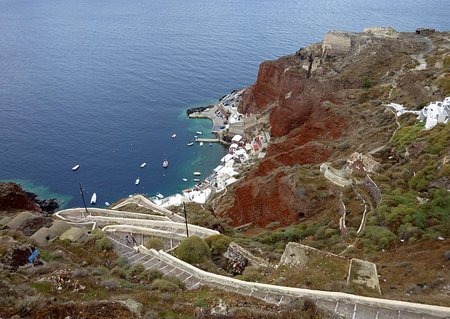
The Aegean sea in brilliant blue form clamours up to the shores and tiny waterfront restaurants offer delectable Greek food that’s often conjured up as and when the fishing boats bring in the latest catch.
Most people get drunk on the beauty of this bay and find it enough to swim and sunbathe as they stare up at the Cycladic white houses that dot the bodies of the red cliffs. Still, others want to swim out to the Saint Nicholas island and go cliff diving for that coveted adrenaline rush. You can always take a donkey ride back up to Oia town or burn off your lavish seafood meal by climbing up those 300 odd steps that connect Amoudi Bay to Oia.
Read: What to see & do at Amoudi Bay
2. Visit Ancient Thera
Once upon a time around the 9th century there lived a proud city perched atop the Messa Vouno Mountain. Theras… the leader of the Spartan colonists founded it and trade routes were established to Kamari and Perissa. The town grew Agora (town squares) and a string of sanctuaries dedicated to ancient Gods. It had a theatre, gymnasium, marketplace, high terraced palatial homes of leaders and small dwellings of commoners and a remarkably organised structure.
Thera fell under Byzantine and then Roman rule and these eras further contributed to its maze of superlative architecture. Though most of ancient Thera is in ruins now, what remains is a magical maze of crumbling buildings, Byzantine walls, Hellenistic temples, inscriptions and etchings … a virtual history treasure hunt.
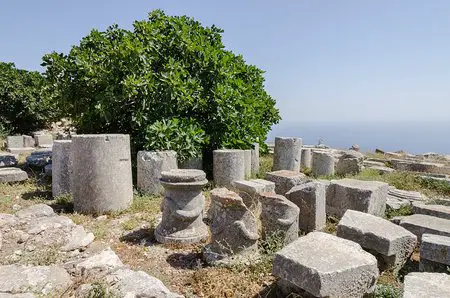
The climb up to Thera is as big an attraction as the site itself… the rather exhausting but exhilarating walk up from Kamari/ Perissa offers splendid views at each step. Driving up is also possible and visitors always pay their respects at the serene white and blue St Stephen’s church that’s at the entrance of the site.
Thera is dotted over with information plaques in English and Greek, so understanding the history of each of its landmarks is not difficult. Time seems suspended in this ancient city that stands atop Santorini’s second-highest peak; Messa Vuono. The lack of crowds and mysticism around this site remains its biggest advantage.
Read: What to see and do at Ancient Thera.
3. Watch the Santorini Volcano
The volcanic eruptions that happened on Santorini islands are still the hottest topics in the geologist and naturalist circles. The creation of the 5 islands; Santorini, Therasia, Aspronisi, Palea Kameni, Nea Kameni are the result of a series of explosions that happened between 1650 BC to the recent 1950. The black and red cliffs of Santorini mainland and its beautiful whitewashed towns with blue-domed churches have graced the covers of umpteen magazines, postcards, posters and TV shows.
The eruptions gave the soil a distinct red and black colour that drew hordes of tourists and gave the island’s wine a unique taste. The history of Santorini is so tightly tied up with that of the volcano that no matter where you wander on the island you will find some evidence of it. The caldera walk between Fira to Oia, boat sail tours around the caldera cliffs and even sunbathing on the Perissa beach will provide you with experiences that are a testimony to the explosions.
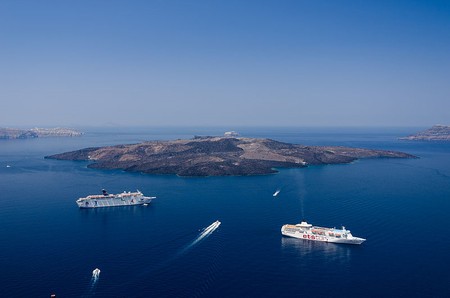
The caldera cliffs, the black sand of Perissa and the red sand on Akrotiri beach are all by-products of the eruptions and have prompted the tourism industry to offer experiences that allow people to get a closer feel of the volcanic activity.
Nea Kameni with its active volcano crater that still hisses out smoke and sulphurous deposits is where tourists go to get a first-hand feel of the volcano. The nearby Palea Kameni with its famous mud baths and sulphur springs has mythical therapeutic powers. Forming the other edge of the caldera is Thirasia with its pebble-strewn lunar landscape… it was once part of Santorini before the fierce eruptions blew it apart.
For getting a more holistic feel of the explosions you can also visit the Akrotiri archaeological site that contains evidence of a Minoan civilization that was wiped out when 3 to 6 meters of ash fell on it after the eruption. If a more romantic experience appeals to you then a sunset cruise in the Aegean waters after you tour the volcanic islands, will be a journey you will remember forever.
Read: How to see Santorini volcanos and what to expect
4. Visit Kamari Beach
Kamari is one of the most visited volcanic beaches in Santorini and it presents the perfect bouquet of activities for beach-loving tourists. The beach is kept spotlessly neat and clean and it has won the coveted Blue Flag award. The lack of debris and vagrant flotsam accentuates the beauty of the black beach that holds a nice boardwalk flanked by gift shops, cafes, bars and restaurants.
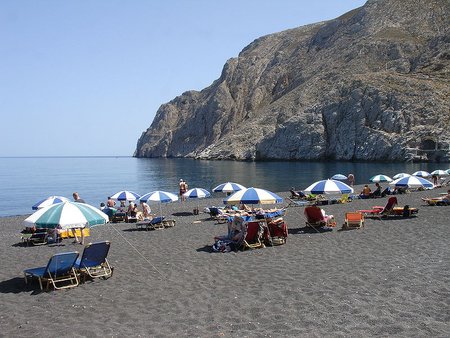
There are a couple of diving centres on the beach that are manned by PADI instructors offering a range of diving activities and courses. You can also engage in other kinds of water sports like paddleboarding, jet skiing, water tube floats etc. or you could choose to engage in beach volleyball or a hearty round of football. There are clean changing room, bathroom and shower facilities. Lifeguards constantly monitor the beach and beachside restaurants rent out umbrellas, sunbeds and water shoes for the convenience of guests.
Locals offer temporary tattoo services and hair braiding services. Choose from a wide range of restaurants including Almira, IL Forno Pizza, Elias Grill Nichteri and a healthy mix of night clubs and sports bars. Watching the sunset, eating local food, sports and even souvenir hunting are just a few of the things you could do in Kamari.
The easy access to Kamari from the airport, as well as Fira, adds to its charm. The hamlet of Kamari lies at the base of the Mesa Vuono Mountain that holds the ruins of ancient Thira.
Read: All about Kamari Beach and what can you do there.
5. Hike from Fira to Oia
The Fira to Oia hike is the most advertised and lauded hike on the Santorini island and it deserves every bit of the praise it gets. For starters, the hike is not a difficult one and can be attempted by not so regular hikers and even beginners. For anyone over the age 10, this is a moderately long hike and can be broken into charming little parts. For instance, you can walk from Fira to Firostefani and then Imerovigli and then take a long break and even stay for a couple of days.
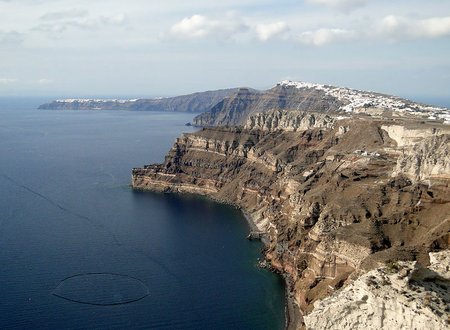
The fit and the determined can continue on the rewarding but exhausting last stretch between Imerovigli and Oia. The towns that fall on the hiking route are perched successively higher up so basically, trekkers keep following the edge of the Caldera dipping into the views and Santorini’s unique culture. Each of Santorini’s star towns i.e. Fira, Firostefani, Imerovigli and Oia have their own charms with their list of lovely churches, cafes, boutiques and colourful local markets.
It’s almost certain that you will not be able to carry on the hike without stopping off to explore the delightful towns of Imerovigli and Firostefani. Even if you don’t venture inside the towns, don’t forget to check out some awesome attractions like the Skaros rock, the female monastery of Agios Nikolaus, Profitis Ilias church and the numerous unnamed photo-stops along the way that open up the loveliness of the volcanic landscape.
Santorini’s star has always been the volcano and the Fira to Oia 10 km walk is the best way to see the beauty of the submerged caldera and the volcano cliffs. Perhaps this is why most people who visit Santorini end up dedicating a day to this hike (which practically shouldn’t take more than 5 hours) that exposes so many facets of natural beauty, food, culture and spirituality on one journey.
Read: The great hike of Fira to Oia
6. Visit Museum of Prehistoric Thera
More than a thousand years ago than the famed Pompeii, a flourishing civilization thrived on the gorgeous Thiras Island. The Akrotiri Minoans had an exemplary taste in paintings, pottery and wall art and went on trade expeditions to distant lands like Egypt. They had rich customs, a sturdy social structure and a well-developed city plan. However, the volcano eruption in 1620 changed it all.
Guided by ancient scientific principles that warned the Akrotiri tribe of imminent danger, the Akrotiri tribe fled on boats and soon the entire site was covered by volcanic ash and lava. Excavations happened and the archaeological world was stunned by the artistry, richness and aesthetics of the finds.
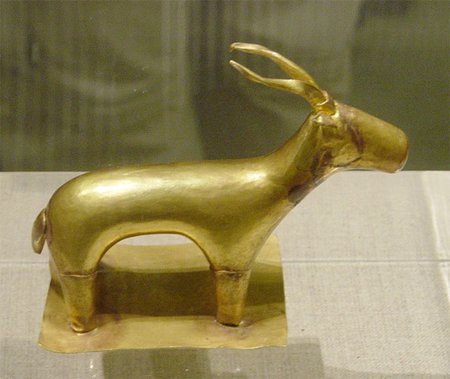
Frescoes with lifelike detailing of blue monkeys and flowers, paintings with flower clad women who seem to step off the frames and come to life, a gorgeous golden Ibex that was only discovered in 1999; it was packed painstakingly by the ancient Minoans who knew that this art will be appreciated by later generations… All this and more is housed inside the Museum of Prehistoric Thera that stands between the city bus stand and cathedral.
The small air-conditioned museum is also one of the best places to learn about the natural and geological history of the island and how it morphed from the circular Thiras to the fragmented volcanic rock filled Santorini, Therasia, Aspronisi, Palea Kameni and Nea Kameni. Expect to see weapons from Bronze Age, fossils from pre-human eras and detailed insight into the lives of the commons folk at Akrotiri and neighbouring Santorini settlements like Potamos.
Read: What to see & Do in Museum of Prehistoric Thera
7. Visit Perissa Black Sand Beach
Perissa lies at the foot of the proud Mesa Vuono Mountain that cradles the ruins of ancient Thera. The settlement of Perissa is a quiet Greek town with its little town square, church, market and orthodox peace-loving people. Yet the glimmering 1.5 km powdered lava stone and pumice beach of Perissa attracts thousands of tourists every month. The dark sand bed even colours the Aegean waters a deep sapphire blue which kind of makes Perissa a photographer’s paradise.
One of the neatest and well-maintained beaches of Santorini, Perissa has won the Blue Flag award. Lifeguards are patrolling the beach and hundreds of sun loungers and sunbeds cover it. You will also see Beachfront restaurants with armies of waiters providing beachside towel, food and drinks service to their stationed umbrellas, sun loungers and tikka huts.
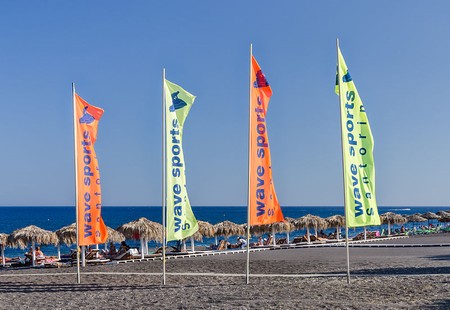
Perissa is known for its new waterpark with slides, entertainment zones for adults and kids, children’s playground, restaurant etc. It’s also known for its dive centres that facilitate all levels of dives; right from beginners to professionals, snorkelling, swimming, speed boat cruises and jet skiing are some other activities that you can experience on the Perissa beach.
If you fancy some fresh Mediterranean food then hop into any one of the small eateries lining the beach. Seafood (most of it freshly caught) is the star here but there are plenty of vegetarian options too. Don’t miss bargain hunting in the tiny shops selling handmade jewellery, local craft and souvenirs… they are lined up with the restaurants.
The best way to get to Perissa (and to the rest of Santorini) is by ATV but you can also drive up or arrive by bus. Bus connections to Perissa are good from Fira and Oia. Once you are done exploring the black sand beach of Perissa, you could go up to Fira to explore its exciting nightlife or stay back exploring the peaceful Perissa town with square and church. The adventurous can take up the challenge of the exhausting but exhilarating 5-hour climb up and across the Mesa Vuono Mountain and view the ancient Thera ruins.
Read: All about Perissa beach and all about its amenities and activities.
8. Take a Tour of Santo Winery
Most people who go to Santorini flock to the cafes and terraced restaurants in Oia at the north end of the island to catch the flaming Santorini sunset in all its beauty. But right at the centre of Santorini there is a place that’s perched up the cliffs and hence is strategically poised to offer the best view of the Caldera. It doesn’t hurt that this place is an award-winning winery and wine cooperative that’s committed to upholding the traditional (and unusual) wine growing practices in Santorini.
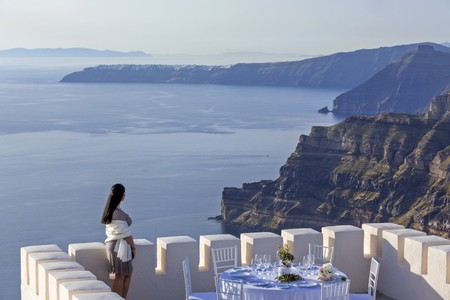
You can enjoy the 1947 established Santo winery in all seasons. In summers sit outside in the patio and enjoy the ‘golden sunset’. In winter afternoons take advantage of the aesthetic cliff terrace seating that looks straight out of a lifestyle magazine. When it’s raining sit under the glass roof covered tasting area and hear the raindrops while sipping your wine. If it’s freezing outside sit indoors and have a sumptuous Mediterranean meal at their gorgeous restaurant that specialises in organic Mediterranean cuisine. Even if you are a teetotaller you can enjoy a tapas and cappuccino session while watching the sunset.
Santo Wines produces some really amazing dessert wines like Vin Santo apart from the acidic and crisp Assyrtiko. Visit the Oneotourism Center to learn about the history of the winery and its products in great detail or visit the wine and organic product shop to stock up on PDO wines and their special anhydrous tomato paste amongst other delectable goods.
And no visit is complete without a wine tasting session of their in-house brands or a vineyard & facility tour of their modernised production processes. Their restaurant serves Mediterranean food with a focus on organic produce and seasonal ingredients. A visit to Santo could happily become a full-day program.
Read: All about what to see & do at Santo Winery
9. Visit the Red Beach
Understandably the most scenic of all of Santorini’s beaches, the Red Beach is coloured in exotic shades of black and red. The Red beach is also called Kokkini Paralia (Kokkini means red in Greek) and the name pays tribute to the oxblood lava rocks left over from the famous Santorini volcano eruptions. The cliffs and rocks around the beach also have some shimmering black and red shingle that creates a beautiful setting for photography. Unsurprisingly, the Red Beach is one of the most photographed beaches of the world and the most photographed beach of Santorini.
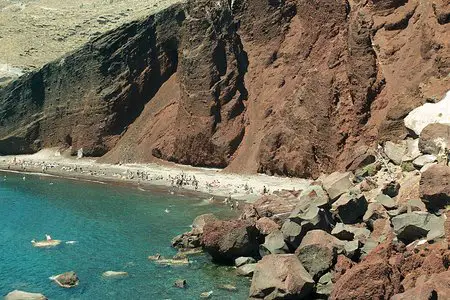
It’s not that great for sunbathing though and the nearby rocky cliffs are known to be prone to landslides. ISMOSAV has marked the Red Beach ‘unsafe’ and yet its enticing beauty calls hundreds of tourists every day to its shores. Bring your own snacks or buy some fruit from the fruit seller near the access road to the Akrotiri Red Beach and eat these sitting on the beach while watching the sun dip below the Aegean Sea.
Or you can go off and explore the small unnamed trails that start off from the Red Beach. Exploring the white church nearby or the small tourist food centre near the beach are also good options. Reaching the Red Beach is best done by boat as the access road from the Akrotiri Archaeological site is a little tough on the knees. You can boat hop to the White Beach and the Black Beach too. Or else a visit to the Akrotiri Archaeological Site that bears the imprint of the same volcanic eruption which shaped the Red Beach, is also a good idea. Whatever you do, a visit to the famed Red beach of Santorini flanked by its iron-rich cliffs is sure to remain branded in your memory.
Read: All about what to see and so at the Red Beach
10. Ride the Cable Car
The Santorini Cable Car has made life easier for thousands of people who had struggled till 1982 because of the huge transportation issue between the Fira old port and Fira town. Fortunately, Santorini’s benefactor and businessman Evangelos Nomikos (he started the Loula and Evangelos Nomikos foundation that aimed to improve the conditions of the 14 different communities living in Santorini) took note of the problem. The foundation bore the entire cost of installing and purchasing the Cable Car which solved a major issue for tourists who wanted to go up the hill to Fira town.
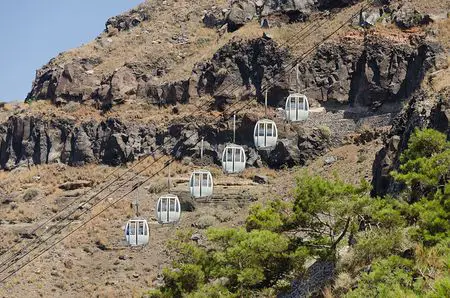
The 4-minute ride by cable car eliminates the need of climbing up 580 steps by foot while dodging donkey poop and donkey kicks. It also negates the need of travelling uncomfortably up via donkey…a tradition that’s an integral part of the Santorini experience though. The cable car provides delightful views of the Aegean waters and the submerged caldera and riders often feel that they are rushing into this stupendous spectacle.
On the other side, the towns and villages of Santorini and the volcanic cliffs are seen in picturesque detail. If you are ascending (this is when the cable car has maximum value) then you will be starting from the cable car station that’s a ten-minute walk away from the pretty old port (Fira Skala) with its small and delightful tavernas selling feta cheese, greek bread, fava, tomato fritters and grilled meats.
Use the cable car to ascend to Fira and enjoy its exciting nightclubs, shops and terraced restaurants… the epitome of Santorini’s urban life. The cable car ride costs 6 euros (one way) and takes only 4 minutes…understandably it is in high demand always. The cable ride comes in super handy when you are holidaying in Fira and have to rush down to the old port to catch a cruise liner… these generally leave on time with or without you!!!
Read: All about Santorini Cable car Ride
11. Visit the Perivolos Black Beach
Many tourists do not know that the black shimmering lava sands that stretch from the base of Mesa Vuono mountain in both directions (Perissa and Kamari) are actually the products of the same volcanic material that compose the Perivolos beach. While Perissa has coarse rocky lava material along its beach line… the black sand gets softer and finer when it reaches Perivolos. This is why Perivolos is the best amongst the black beaches of Santorini, especially when it comes to enjoying parties, chilling out and lazing on the beach.
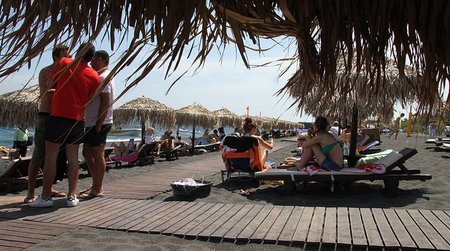
The beach is just 14 km away from the Kamari airport and 11 km away from Athinios port. Santorini’s capital Fira is 12 km away from the Perivolos beach and while the bulk of the tourist crowd from Fira go to Perissa and Kamari; a discreet and quieter lot of people walk to the Perivolos beach from Perissa beach (a comfortable 2 km walk).
You will also see a lot of glamorous Grecians who are a permanent part of the nightclub scene in Santorini, partying at Perivolos. Some of the best bars and party places here are Jojo’s, Wet Stories and Chilli Beach Bar. Not to mention excellent restaurants like Terra Nera, Seaside by Notos etc. that appeal to couples and families looking for quiet sophisticated places. There aren’t many hawkers roaming the beach though lifeguards patrol each inch of the black sandy stretch.
There is a conspicuous absence of small souvenir shops and tattoo parlours but there are excellent water sports operators including Wave Sports who do volcano tours, as well as jet ski tours around the island. Most visitors love the offbeat yet vibrant party scene at Perivolos and enjoy the eclectic mix of dance shows, guest DJ performances and beach basketball tournaments. No matter what your preferences and tastes in beach entertainment are… you are sure to find something to your taste in Perivolos.
Read: Find out what to see & do at Perivolos beach.
12. Visit the Akrotiri Archaeological Site
Akrotiri Archaeological Site is work in progress… excavation work has been going on here for the last 50 years. This is the site where an entire democratic civilisation thrived before the Thera earthquakes caused its inhabitants to flee in boats with their valuables. The volcanic eruption that followed covered the city in a thick layer of lava and ash (some of it was 40 meters high).
Historians say that less than half of this huge city is yet to be excavated, so every day there is the chance of an amazing new artefact to be discovered. The Akrotiri site had splendid frescoes and wall art besides beautiful vases and though most of these have been moved to the Museum of Prehistoric Thera in Fira and the National Archaeological Museum in Athens, what remains is also spectacular.
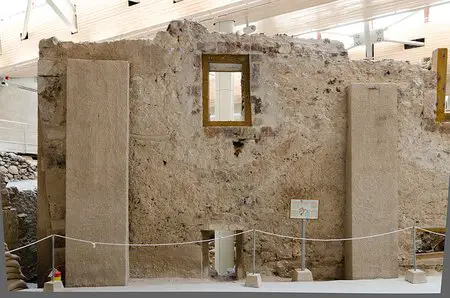
A whole submerged city encased in a modern wood and metal building that’s facilitated with walkways and paths; the entire concept is an engineering and archaeological marvel!! Entire pieces of furniture have been reconstructed by pouring plaster into the casts that were left behind by the eruption. There are chairs, tables, bathtubs and evidence of drainage and heating systems.
The entire site is covered by a metal and wood airy building that lets in light but protects the site from damage. The walkways running through the site allow visitors to get up close to the buildings and see the artefacts and art from close quarters. To do justice to this Bronze Age site, you must read the information plaques carefully and gain a comprehensive understanding of the natural disaster that struck Akrotiri (earthquake and volcanic eruption).
Ideally, take a guided tour and visit the Prehistoric Museum of Thera afterwards… you will gain an unforgettable insight into the lives of this civilised, refined and prosperous clan who thrived in Santorini eons ago.
Read: All about Akrotiri Archaeological Site and what to see & do there
 A travel addict. Still celebrating the day when he quit his high-profile corporate job to pursue his passion for travel writing.
A travel addict. Still celebrating the day when he quit his high-profile corporate job to pursue his passion for travel writing.